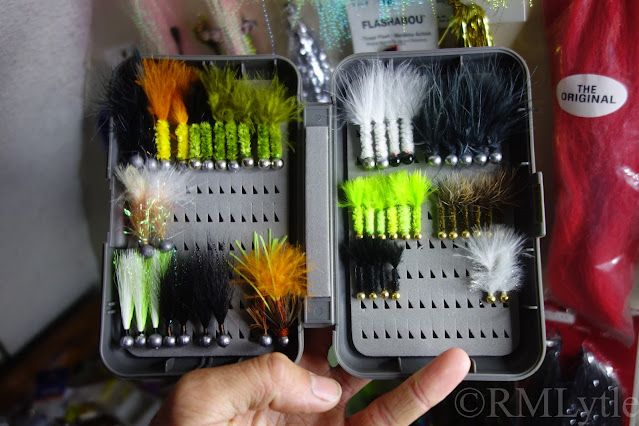Hair and feather jigs are some of the most utilitarian lures in the fishing world. Cheap, simple, and easily fished, small jigs bridge the gap between fly fishing and gear fishing. I was generally reluctant to start fishing jigs with a fly rod under the misconceived idea that they'd be too heavy. Then, in a fly swap, I received some flies tied on simple dart jigs by shad guru Sonny Yu. I eventually got around to trying them, but not for shad. The first time I used jigs on a fly rod was while targeting trophy sized yellow perch. They quickly proved their utility.
Before I started using jigs, I didn't have a particularly good understanding of how specific weights fished. I'd tie nymphs and streamers with brass or tungsten beads or cones, copper wire, lead wire, non-lead wire, dumbbell eyes, and other materials to add weight but I didn't pay much attention to specific weights. When I started to tie jigs that was suddenly the foremost factor. I was buying weights as much as I was sizes: 1/64oz, 1/32oz, 1/16oz, so on and so forth. I knew pretty much exactly how heavy a fly I was tying, minus added material. It turns out that's a huge game changer for a fly tier and angler. I now could correspond how a fly fished in different scenarios directly with its weight. I could also see how different materiel and fly sizes impacted the sink rate and action of jigs of the same weight. For example, a long and bushy bucktail in 1/16th oz sinks quit a bit slower than a short, sparse one. The part of the tail I tied with had an impact too, of course. I could then make a pattern of the same size and material on different weight heads to fish different depths and different current speeds. That's huge. Jigs made learning it easy and lead to me paying a whole lot more attention to the weight of the other flies I tie.
Jigs also just seem to work really really well, often when other offering won't. Two people's catch rates in particular heavily influenced my interest in tying and fishing jigs: Tim Galati (www.youtube.com) and Josh Rayner (www.ctfishnerd.com). Tim's success regularly catching trophy sized fish of a variety of species on bucktail jigs piqued my interest, and Josh's regular success with his own hand tied jigs at times I'd previously had a hard time catching similar numbers and sizes. Noah caught on a bit quicker, resulting in a few really big early season smallmouth bass, at which time we proposed building a shrine to Tim Galati. The bucktail jig is magic, it really is. And at sizes under 1/8oz they can be fished to exceptional effect on a fly rod. I found that using such jigs on a floating line allowed me to very effectively fish 5 to 10 feet of water early and late in the season for less aggressive bass and walleye in my local lake. It opened up new spots where I'd previously felt I was fishing dead water. I could now feel bottom contours and regularly catch fish where I wasn't previously. As soon as I knew how to fish a spot with jigs, I could easily switch over to other flies and lines and find success that way as well. But the jigs just flat-out worked, so I only occasionally bothered to switch it up.
Jigs also present extraordinarily well under a float. The number of impressive fish I've caught on a 1/64oz chartreuse marabou jigs under a Thingamabobber is ever-growing. Last spring I got walleye, crappie, carp, and a huge smallmouth on that rig. When the water is cold and the fish are sluggish, particularly either with slow current or light wave action, this has been exceedingly deadly. Sometimes fish want very little horizontal movement, and retrieving the jig through the zone won't result in many hookups. A float allows you to hang a jig at an exact depth. This can be huge when it comes to suspending fish like crappies, especially when shore bound and fishing to schools that are further away than the tip of your rod. It's just vertical jigging at a distance. Wave action adds action to your jig, so wind is often helpful with this strategy.
Another huge benefit of these simple jigs is their affordability. I tie my own, of course, which gives me creative control over size and color combinations. Mine are either all marabou, marabou with a chenille body, woolly buggers, or bucktail jigs. Getting jigheads on the cheap is exceedingly easy, and oftentimes scrap materials left over after tying nicer, fancier flies and perfectly suitable for simple little jigs. You can get more out of what you were probably already buying anyway. Of course if you don't tie, you can get get marabou jigs exceedingly cheap at just about any walmart. Or, if you want something specific, you can send me an email and I can put together a custom order. If you're using them as flies it definitely doesn't feel as much like a travesty if you have a bit of creative control.
That brings up a fun question... are these jigs flies? You'll have to answer that yourself, but I'll leave you with two facts: I've cast a Clouser Minnow about 45 feet with a medium light spinning rod, and I've fished an inline spinner very effectively on a 9' 5wt fly rod. The gap was bridged years ago, it's all in what you chose to make of it.
Thank you to my Patrons; Erin, David, John, Elizabeth, Brandon, Christopher, Shawn, Mike, Sara, Leo, C, Franky, Geof, Luke, Streamer Swinger, Noah, Justin, Sean, Tom, and Mark for making Connecticut Fly Angler possible. If you want to support this blog, look for the Patreon link at the top of the right side-bar in web version.



No comments:
Post a Comment